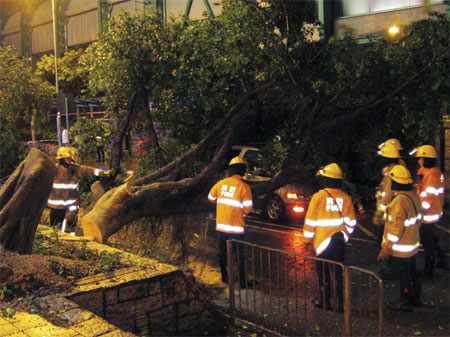Public transportation put under severe test
Updated: 2012-07-24 07:20
(HK Edition)
|
|||||||
|
Firemen try to remove a broken tree which hit a car in rural Taipo district during typhoon Vicente's visit on Monday. Bobby Yip / AFP |
Storm predicted to intensify and continue through Tuesday morning
Hong Kong, which prides itself as having one of the best public transportation systems in the world, was put to test as thousands of workers crammed the MTR, heavy rail and light rail systems, public buses, cross-harbor tunnel buses, taxis, ferries and trams, to get home safely before the storm worsened.
At 4 pm on Monday, Hong Kong port operator Modern Terminals as well as other terminal operators started to shutdown the port's operations by tying down containers and other equipment to prevent them from being damaged by the storm.
Hong Kong port is the world's third largest container port, after Shanghai and Singapore port. By 5 pm, all activities came to a halt.
Although, flights at Hong Kong International Airport continued, passengers were asked to check with their respective airlines as the weather worsened with the approach of Vicente. By 10 pm, 15 passenger flights were cancelled and 212 delayed, the airport said.
The ferry services between Hong Kong and Macao halted operations on Monday afternoon as the gale approached. The ferry services from Central to Cheung Chau and Mui Wo islands were also suspended. Two routes between Tsim Sha Tsui and Wanchai, Tsim Sha Tsui and Central also ceased operations at 7 pm.
The MTR augmented services during the peak rush hour, and indicated that it expected to continue to provide services during the storm. However, large crowds still formed at some MTR stations, such as Central, as offices closed to allow their staff to go home earlier than usual.
The public also formed long queues at bus stops to rush home on the crowded buses. Major bus company operators Citybus & New World First Bus canceled their overnight services on Monday night.
According to the Hospital Authority, as at 11 pm, a total of 34 people, including 16 males and 18 females, aged between 4 and 86, have sought medical treatment at the Accident and Emergency Departments at public hospitals. Fourteen of them were admitted.
Two hundred reports of fallen trees were received by the Development Bureau and the Leisure and Cultural Services Department across the city as the storm raged.
The Home Affairs Department said it had opened 23 temporary shelters, and 225 people have sought refuge at the shelters.
As the storm blew over Hong Kong, several pedestrians were bit by flying pieces of wood panel along Connaught Road Central. One of the injured received hospital treatment.
All schools were suspended on Monday. The Education Department called on contingency measures to ensure the safety of students.
Ting Kau Bridge in the New Territories was closed, while vehicles higher than 1.6 meters were forbidden from Stonecutters Bridge.
At 12:45 am the Hong Kong-Shenzhen railway link ceased operations because a tree reportedly fell across its track during the storm.
But no reports of flooding or landslide were received.
According to Wikipedia, the previous Storm Signal No 9 was hoisted by the Observatory in August, 2008 when typhoon Nuri hit Hong Kong. News report said that the maximum sustained wind recorded at Waglan Island was at 94 kilometers per hour.
Prior to that, a No 9 signal was hoisted way back in Sept 2003, when typhoon Dujuan battered the city.
(HK Edition 07/24/2012 page1)
